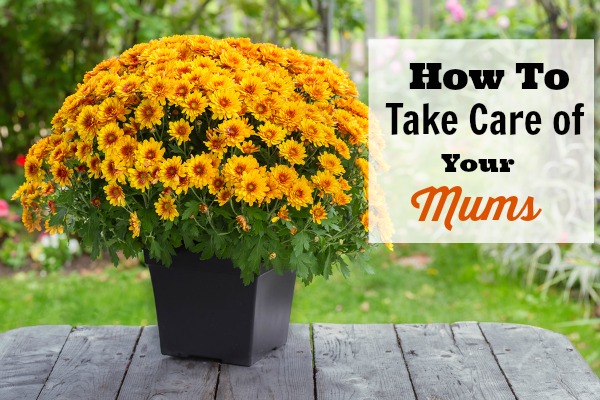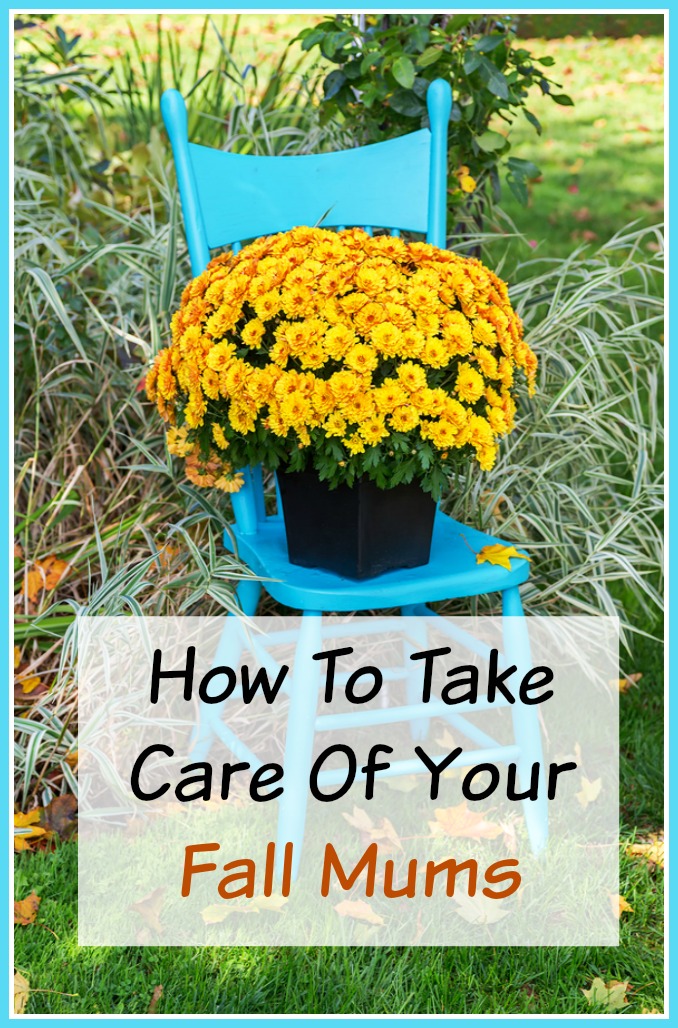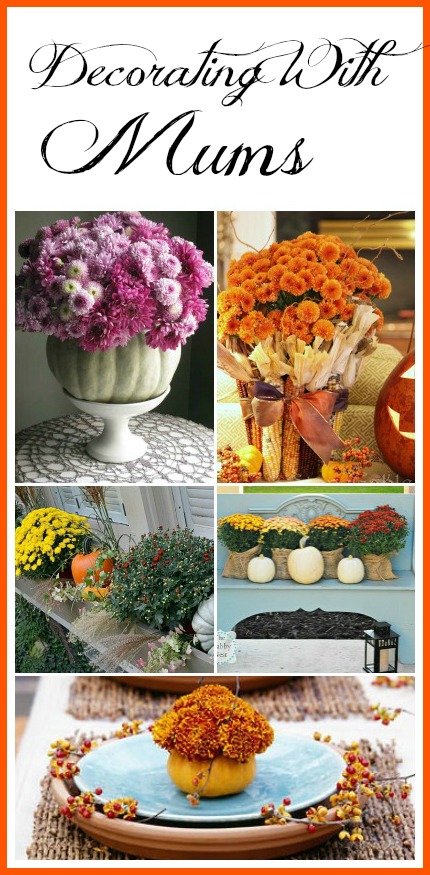How to Care for Fall Mums.
Chrysanthemums (AKA “mums”) are a popular perennial flower to use in your fall decorating. This is partly because of how pretty they are (all those lovely Autumn colors they come in), and partly because of how easy they are to take care of! In fact, mums can pretty much be planted at any time of the year. They really aren’t that hard to take care of. Mums can thrive both in your garden beds outside or in pots. If you’ve got a new bunch of mums and you want to make sure they can grow well and look their best, then you’ll like these tips on How to Take Care of Mums (Indoors and Out)!
Disclosure: This post may contain affiliate links to Amazon and/or Etsy, which means that I may earn a small commission from some of the links in this post. Please see our Disclosure Page for more information.
Mums come in a bunch of different colors and varieties! During the fall, consider getting several mums in fall colors like yellow, orange, and red. During other seasons you may enjoy getting mums that are white, pink, purple, or even blue!
How to Take Care of Mums (Indoors and Out)
Regardless of whether you’re getting your mums for inside your home or outside, if you want their blooms to last the longest, get ones where the flowers haven’t opened yet. Unless of course, you have a party or something happening soon and you need the mums for your decor. In that case, it’d be best to get fully flowered ones, rather than waiting and hoping the flowers open in time.
Taking Care of Mums Indoors
1. If you want to take care of your mums indoors, the first thing you should do is to make sure they’re in a pot with adequate room for their roots to grow. Also, the pot should be filled with a good potting mix that provides decent drainage. Alot of us just buy mums for fall decor and just stick them in a pretty pot while still in their black garden center pot. Your mums will last longer if you actually take the time to repot them.
2. Next, make sure your mums are getting enough sunlight. Mums love the sun, so indoor mums will do their best if placed close to a window that lets a lot of sunlight in everyday.
3. Also make sure to give your mums enough water. And don’t just pour water over the top of them and let it drip down into the soil. That’s just asking for the plants to develop fungi. Instead, water close to the roots of the plant, saturating the soil, not the leaves or too much of the stems. Mums should be watered frequently when first potted, then given about 1 inch of water a week, once they’re more established. If their leaves start to wilt, they need to be watered more frequently. Indoor mums should not need plant food or extra fertilizer.
4. Lastly, don’t forget to “deadhead” your mums as necessary. To deadhead your mums, you can use your fingers or pruning shears to pinch off any dead flowers. Try to cut them off above the next set of leaves on the stem. You can also remove dead leaves when deadheading. Deadheading your mums helps to both make your mums look neater and prettier, and helps to extend how long they bloom.
Different varieties of mums grow and flower at different rates. But in general, indoor mums only flower for about 1 month. Once the flowers are gone, you’re essentially left with a little bushy green plant. At that point you can choose to compost your mums, or try to transplant them outside.
If you choose to transplant them, you may want to wait until spring depending on what zone you’re in. Since I live in Georgia, I’ve always been able to plant my mums even as late as December and still have them come back the following year. Also, since indoor varieties tend not to be as hardy as outdoor ones, do your best to give your outdoor transplants extra mulch. An indoor mum successfully transplanted outside should bloom again the next fall.
RELATED: Gorgeous Examples of How To Decorate With Mums
Taking Care of Mums Outside
Just as it’s easy to take care of your chrysanthemums indoors, it’s very easy to take care of mums outside!
1. Like indoor mums, outdoor mums should be planted in a place where they have plenty of space. They have shallow roots and don’t thrive well when in areas with other plants’ roots to compete with. A good rule is to keep them at least 18 inches apart (remember, they’ll get bushier as they grow!). They should be placed in a hole that’s about a foot deep, so their roots are appropriately covered but their leaves are free. Mums do especially well if planted in soil that has compost added.
2. Watering outdoor mums is pretty much the same as indoor mums especially if they are still in their pots. Give them plenty of water in the week or so after planting, then give them about one inch per week after that. Don’t let them wilt.
3. Unlike indoor mums, if you want to take care of your mums outdoors you will want to fertilize them. But you don’t need to fertilize them until the next growing season when they start to get new growth. At that point, they should be fertilized at least once a month until August.
4. Outdoor mums may also need to be overwintered depending on what zone you’re in. To do this, before the first hard frost hits, you need to mulch your mums very well. Give them straw or wood chips, and pile it high, surrounding the entire base of the plant. If the winter’s frost blackens your mums (more common in the northern states than in the south), just cut them down so they’re only about an inch high, keeping the mulch at least 3 inches high. You can deadhead your mums when overwintering, but don’t prune any stems until the weather gets warmer (excluding cases where you have to cut blackened mums back). When the weather starts to warm up you can also start spreading the mulch out further to make room for the mums’ new growth.
More Mum Info
You technically can also overwinter your mums indoors, though it can be a bit tricky. Once the first frost has blackened them and you’ve cut them down, put them in a pot and bring them into a dark place that is cool (between 32-50°F). Outside in a shed will probably be too cold, so you may have to do this in your garage or basement. Insulate the pot by surrounding it with several layers of newspapers, or an old blanket. Don’t forget to water your mums during their indoor overwintering. 1-2 inches of water 3 times a month is usually enough, but don’t let the soil get dry.
In the spring, when it’s about a week out from the last expected frost, take your potted mums outside to where you’ll want to keep them in the spring through fall. Leave them there for 2-3 hours, then bring them back in. Each day repeat this, and each day add an hour onto that time. When the final frost has passed, your mums are ready to live back outside again.
If you keep growing your mums over several years, after 3 years, it may be good to move them somewhere else in your yard. This reduces the chance of disease and pest infestations. You also need to divide your mums every 3-4 years. Do this in the spring when the plants are creating new growth. Dividing mums is easy. Just use a spade or knife to cut the outer parts of the plants from the center. You can then compost the center and spread out your divided mums into new holes with fresh soil.
Lastly, don’t forget to regularly deadhead your outdoor mums, too! It’ll keep them looking nice. You might also want to pinch your mums’ buds to make them bloom as much as possible. This doesn’t need to be done on mature fall plants, but it should be done on younger mums that you plant in the spring. From the first growth of buds until July, every 2-4 weeks you’ll want to pinch off half of the new growth that your mums have produced at the top of their stems. The stems don’t all have to have flower buds on them.
So as you can see, mums are pretty easy to care for. They’re not very delicate, and pinching, pruning, and dividing them takes hardly takes any time. That’s why mums are a wonderful choice of flower for your home, indoors or out!
Have you ever grown mums before?
This post contains affiliate links to Amazon. Please see our Disclosure Page for more information.
You might also be interested in:



I love mums and have always had good luck growing them outside. Have never tried them in the house. This year though I’m not having very good luck. I think I have moles, and their killing them. I only have one left out of three. Maybe I need to give growing them inside a try. Thanks for the tips!
Someone at our local Nursery told me, years ago, that if you have mums growing from Spring through early Summer, when you see a bud, pinch it off. Don’t let the buds form UNTIL July 4th. From that point on, do NOT pinch any blooms. It has worked for me for years, and I always have full blooms on the plants from later in August through the first frost. I am in Wisconsin in Zone 5a.
Thanks so much for all the excellent tips on growing indoor/outdoor Mums. I had no idea.
I have a Mums plant gotten at grocery store last Fall, somehow kept it growing indoors all year, did transplant it to bigger pot. It’s very dry here with lots of alkali in our soil. Would like to plant this one outside in Spring( if it’s still alive). We do have cold winters here in western CO.
Thx again for tips.
Hope you have wonderful week
Thanks for the tips! This year I’m going to plant mums in my garden. They’re very beautiful…
I just purchased a few mums, so your tips are perfect. Thanks for sharing.